Baby Oral Health for Parents
Your Baby’s Mouth
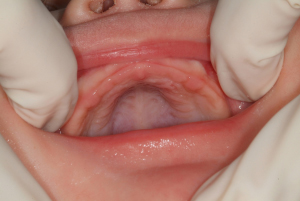
Healthy Gums
Your child has 20 baby teeth that are already forming before birth. You will probably notice your child’s first teeth coming through the gums when he/she is six to eight months old. Bottom front teeth (central incisors) usually come in before the top front teeth (central and lateral incisors). Teeth often come in pairs. Do not worry if some teeth come in a few months later as children can have different timing. If your baby’s teeth come in earlier, begin brushing the teeth daily (see Mouth Cleaning section).
Babies can be fussy when teeth come into the mouth. You may see more finger sucking, gum rubbing and drooling. High fever and diarrhea are not from teething. Call your doctor if your baby has a high fever for more than a day or two. You should not use products like Baby Orajel because in rare cases, it can cause a child to turn blue and stop breathing. Instead, your child can use a safe teething toy. Safe toys are one-piece, have no paint on the outside, and are bigger than the hole in a roll of toilet paper.
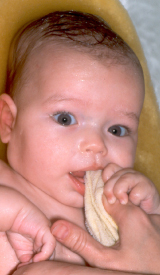
Wiping Gums
Use a moist washcloth to wipe your baby’s gums after feeding. Look at your baby’s gums regularly. If you see anything strange or if something changes, let your child’s doctor know. Ask whether you should take your child to a dentist and get a referral if needed.

Grain of rice of toothpaste
Begin brushing once your baby’s teeth come in. Brush at least twice a day with a soft toothbrush. Use a small amount of fluoride toothpaste and a gentle circular scrubbing motion. The amount of toothpaste you should use is about the size of a grain of rice (see picture). Set a good example for your child by taking care of your own teeth and gums. Taking care of your teeth and gums can help prevent passing germs that cause cavities to your child.
-
BORN WITH TEETH: Your baby may be born with a tooth called a ‘natal tooth’ or may get a tooth during the first month after birth. This is called a ‘neonatal tooth’. Most of the time, these teeth are one of the child’s 20 baby teeth. Check your baby’s mouth to make sure the tooth is not making a sore on the bottom of the baby’s tongue. The tooth may be loose because the root has not fully formed. Speak to your doctor if you have soreness with breastfeeding.
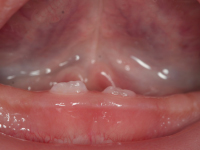
Born with teeth
-
THRUSH: If there are white-looking spots in your baby’s mouth (look like cottage cheese), he/she may have oral thrush. If this gets worse or causes problems, take your baby to the doctor or dentist. The doctor or dentist will check it and treat it if needed.
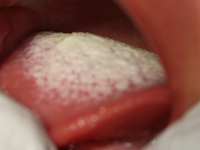
Thrush on the tongue
-
BUMPS ON GUMS: Your baby may have smooth whitish bumps on the gums. This may be something called ‘Bohn’s nodules’. Check with your doctor or dentist. Bohn’s nodules are harmless and usually disappear within the first three months of life.
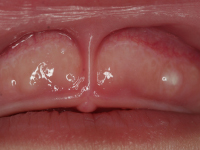
Bumps on the gums
- CLEFTS: Cleft lip and/or palate (roof of the mouth) is the most common major oral-facial birth defect. If your baby has this, work with your doctor to find a specialist team to help care for your baby. Watch this parent video on team

General Oral Health Information
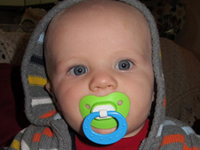
Social and Emotional Growth (Development)
-
0 to 3 months

Breastfeeding
At this age, your child will begin to show emotions, often being content or distressed. Your baby is learning to rely on you for comfort or to relieve distress. Crying is often a sign of distress or discomfort. However, babies this age often have emotions we do not understand. Starting at 4 to 6 weeks of age, some babies cry for no apparent reason. If this happens for more than 3 hours per day, it is called ‘colic’. Try to avoid using the bottle or breastfeeding to help him/her get to sleep. Avoid using food as a distraction for crying.
-
3 to 6 months
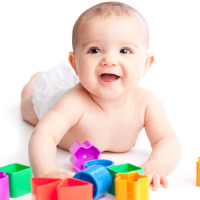
Your child’s emotions will become more obvious. Babies become more aware of what is around them. He/she will smile joyfully, and may squeal, gurgle, babble, and laugh, often in response to your actions. Your baby may respond to your facial expressions and imitate them. This is an ideal age to encourage B’s before bedtime. The B’s are bath, bottle/breastfeeding, brush (or wipe gums if teeth not present), book (or other quiet activity), and bed. You can change the order of these activities, but be sure that brushing (or wiping gums) comes right after feeding.
